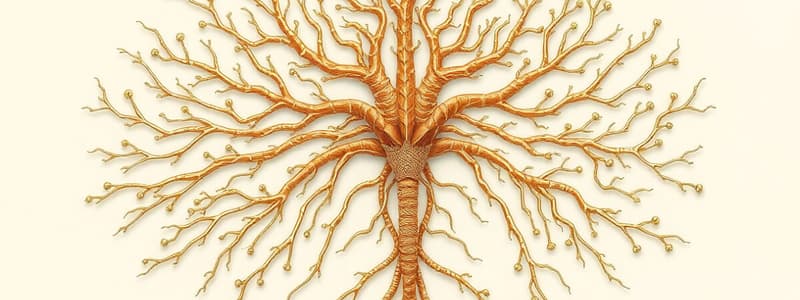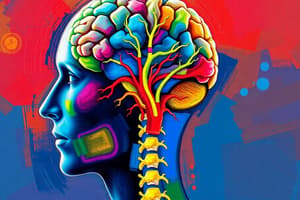Podcast
Questions and Answers
What is the primary function of the afferent division of the nervous system?
What is the primary function of the afferent division of the nervous system?
- To process and transmit nerve signals
- To carry sensory information to the CNS (correct)
- To relay signals from the CNS to glands
- To deliver motor commands to skeletal muscles
Which part of the nervous system is responsible for voluntary muscle contractions?
Which part of the nervous system is responsible for voluntary muscle contractions?
- Autonomic nervous system
- Parasympathetic division
- Sympathetic division
- Somatic nervous system (correct)
What role do neuroglia play in nervous tissue?
What role do neuroglia play in nervous tissue?
- They transmit electrical signals
- They primarily detect changes in stimuli
- They control skeletal muscle contractions
- They support and protect neurons (correct)
Which term describes the division of the nervous system that controls subconscious actions?
Which term describes the division of the nervous system that controls subconscious actions?
Which division of the nervous system has a stimulating effect on the body?
Which division of the nervous system has a stimulating effect on the body?
What type of sensory fibers are responsible for transmitting information from internal organs?
What type of sensory fibers are responsible for transmitting information from internal organs?
What distinguishes the efferent division from the afferent division?
What distinguishes the efferent division from the afferent division?
Which of the following statements about the autonomic nervous system is true?
Which of the following statements about the autonomic nervous system is true?
What is contained within the cytoplasm of the neuron, which is specifically referred to as the Perikaryon?
What is contained within the cytoplasm of the neuron, which is specifically referred to as the Perikaryon?
What role do Nissl bodies play in the neuron?
What role do Nissl bodies play in the neuron?
Which statement best describes dendrites in a typical neuron?
Which statement best describes dendrites in a typical neuron?
Neurofibrils within a neuron primarily serve what function?
Neurofibrils within a neuron primarily serve what function?
During neurotransmission, what is the role of synaptic vesicles?
During neurotransmission, what is the role of synaptic vesicles?
Which statement best describes the role of the Central Nervous System (CNS)?
Which statement best describes the role of the Central Nervous System (CNS)?
What distinguishes the axon of a neuron from its dendrites?
What distinguishes the axon of a neuron from its dendrites?
What constitutes the composition of gray matter?
What constitutes the composition of gray matter?
What kind of communication occurs at a neuronal synapse?
What kind of communication occurs at a neuronal synapse?
What is the significance of mitochondrial presence in the neuron?
What is the significance of mitochondrial presence in the neuron?
Which of the following is NOT a function of the nervous system?
Which of the following is NOT a function of the nervous system?
Which components are part of the Peripheral Nervous System (PNS)?
Which components are part of the Peripheral Nervous System (PNS)?
Neurons are classified based on which criteria?
Neurons are classified based on which criteria?
What structural feature differentiates the brain from the spinal cord in the CNS?
What structural feature differentiates the brain from the spinal cord in the CNS?
What role do neuroglia play in the nervous system?
What role do neuroglia play in the nervous system?
Which component is primarily responsible for the conduction of nerve signals?
Which component is primarily responsible for the conduction of nerve signals?
Which term best describes the function related to the nervous system's response to stimuli?
Which term best describes the function related to the nervous system's response to stimuli?
Which statement about sensory receptors in the PNS is true?
Which statement about sensory receptors in the PNS is true?
Which type of neuroglial cell is mainly responsible for forming the blood-brain barrier (BBB)?
Which type of neuroglial cell is mainly responsible for forming the blood-brain barrier (BBB)?
What is the primary function of Schwann cells in the peripheral nervous system?
What is the primary function of Schwann cells in the peripheral nervous system?
Which of the following statements accurately describes oligodendrocytes?
Which of the following statements accurately describes oligodendrocytes?
Which cell is the least abundant type of neuroglia in the CNS?
Which cell is the least abundant type of neuroglia in the CNS?
What process do the nodes of Ranvier facilitate?
What process do the nodes of Ranvier facilitate?
Which component of the nervous system includes both the somatic and autonomic nervous systems?
Which component of the nervous system includes both the somatic and autonomic nervous systems?
What is the primary role of ependymal cells in the nervous system?
What is the primary role of ependymal cells in the nervous system?
How do satellite cells function in the peripheral nervous system?
How do satellite cells function in the peripheral nervous system?
What distinguishes the regeneration capabilities of peripheral nerves from central nerves?
What distinguishes the regeneration capabilities of peripheral nerves from central nerves?
Which of the following neurotransmitters is NOT classified as a catecholamine?
Which of the following neurotransmitters is NOT classified as a catecholamine?
Which of these statements about the axon is incorrect?
Which of these statements about the axon is incorrect?
What component forms the outermost covering layer of a peripheral nerve axon?
What component forms the outermost covering layer of a peripheral nerve axon?
Which division of the autonomic nervous system is responsible for the 'fight or flight' response?
Which division of the autonomic nervous system is responsible for the 'fight or flight' response?
Which function is not attributed to neuroglial cells?
Which function is not attributed to neuroglial cells?
Flashcards
Major function of Nervous System
Major function of Nervous System
The nervous system receives information from internal and external sources, processes it, communicates the information, and then responds.
Central Nervous System (CNS)
Central Nervous System (CNS)
Part of nervous system including brain and spinal cord; processes information.
Peripheral Nervous System (PNS)
Peripheral Nervous System (PNS)
Part of nervous system that receives input, sends output to and from the CNS.
CNS components
CNS components
Signup and view all the flashcards
CNS functions
CNS functions
Signup and view all the flashcards
Nervous tissue
Nervous tissue
Signup and view all the flashcards
Neurons
Neurons
Signup and view all the flashcards
Neuroglia
Neuroglia
Signup and view all the flashcards
Sensory input
Sensory input
Signup and view all the flashcards
Motor output
Motor output
Signup and view all the flashcards
Neuron Cell Body
Neuron Cell Body
Signup and view all the flashcards
Dendrites
Dendrites
Signup and view all the flashcards
Peripheral Nervous System
Peripheral Nervous System
Signup and view all the flashcards
Afferent Division
Afferent Division
Signup and view all the flashcards
Axon
Axon
Signup and view all the flashcards
Neurotransmitters
Neurotransmitters
Signup and view all the flashcards
Efferent Division
Efferent Division
Signup and view all the flashcards
Somatic Nervous System (SNS)
Somatic Nervous System (SNS)
Signup and view all the flashcards
Synapse
Synapse
Signup and view all the flashcards
Nissl bodies
Nissl bodies
Signup and view all the flashcards
Autonomic Nervous System (ANS)
Autonomic Nervous System (ANS)
Signup and view all the flashcards
Perikaryon
Perikaryon
Signup and view all the flashcards
Sympathetic Division
Sympathetic Division
Signup and view all the flashcards
Neurofibrils
Neurofibrils
Signup and view all the flashcards
Parasympathetic Division
Parasympathetic Division
Signup and view all the flashcards
Nervous Tissue Composition
Nervous Tissue Composition
Signup and view all the flashcards
Axon Hillock
Axon Hillock
Signup and view all the flashcards
Myelin Sheath
Myelin Sheath
Signup and view all the flashcards
Nodes of Ranvier
Nodes of Ranvier
Signup and view all the flashcards
Astrocytes
Astrocytes
Signup and view all the flashcards
Ependymal Cells
Ependymal Cells
Signup and view all the flashcards
Oligodendrocytes
Oligodendrocytes
Signup and view all the flashcards
Satellite Cells
Satellite Cells
Signup and view all the flashcards
Schwann Cells
Schwann Cells
Signup and view all the flashcards
Neurilemma
Neurilemma
Signup and view all the flashcards
Myelin Function
Myelin Function
Signup and view all the flashcards
Schwann Cell vs Oligodendrocyte
Schwann Cell vs Oligodendrocyte
Signup and view all the flashcards
Study Notes
Nervous System Fundamentals
- The nervous system is the body's master control and communication system.
- It receives information from inside and outside the body, processes this information, and then responds accordingly.
- The nervous system is organized into two main divisions: the central nervous system (CNS) and the peripheral nervous system (PNS).
Central Nervous System (CNS)
- The CNS includes the brain and spinal cord.
- The CNS processes sensory information, coordinates responses, and controls higher-level functions like intelligence, memory, and behavior.
- The CNS contains neural tissue, connective tissue, and blood vessels.
Peripheral Nervous System (PNS)
- The PNS consists of all neural tissue outside the CNS, including nerves and ganglia.
- The PNS delivers sensory information to the CNS and motor commands from the CNS to muscles and glands throughout the body.
- The PNS also contains sensory receptors that detect changes in the internal and external environment.
Functional Divisions of the Nervous System
- The nervous system has an afferent (sensory) division and an efferent (motor) division
- The afferent division delivers sensory information from the PNS to the CNS.
- The efferent division carries motor commands from the CNS to muscles and glands.
- The efferent division is further categorized into somatic (voluntary) and autonomic (involuntary) nervous systems
- The Somatic nervous system controls voluntary activities like skeletal muscle movement.
- The Autonomic nervous system regulates involuntary activities including heart rate, digestion, and glandular secretions. The autonomic nervous system is further split into the sympathetic and parasympathetic divisions.
Nervous Tissue
- Nervous tissue consists of neurons and neuroglia (supporting cells).
- Neurons process and transmit nerve signals.
- Neuroglia nourish, support, and protect neurons.
Neuron Structure
- The typical neuron consists of a cell body, dendrites, and an axon.
- The cell body contains the nucleus and other organelles.
- Dendrites receive signals from other neurons.
- The axon transmits signals away from the cell body.
- The axon often has a myelin sheath for faster signal transmission.
Neuroglia (Supporting Cells)
- Neuroglia in the CNS (central nervous system):
- Astrocytes: Most abundant, provide support and form the blood-brain barrier (BBB).
- Oligodendrocytes: Form myelin sheaths around axons in the CNS.
- Microglia: Act as the immune system in the CNS, and are defensive in nature.
- Ependymal cells: Line cerebrospinal fluid-filled cavities.
- Neuroglia in the PNS (peripheral nervous system):
- Schwann cells: Form myelin sheaths around axons in the PNS that allow for regeneration if damaged.
- Satellite cells: Surround neuron cell bodies in ganglia; provide support and regulate environment around the neurons.
Neural Synapse
- Neurons communicate with each other at synapses.
- Neurotransmitters are chemical messengers that transmit signals across synapses.
Classification of Neurons
- Neurons are classified by their structure and/or function.
- Anatomical classification include Unipolar, Bipolar, Pseudounipolar, and Multipolar based on their shape.
Functional Classification
The following additional classifications are based on the directionality of the signal:
- Sensory neurons transmit messages to the central nervous system.
- Motor neurons transmit messages away from the central nervous system.
- Interneurons connect sensory and motor neurons.
Myelin Sheath
- The myelin sheath is a fatty substance that coats some axons.
- It acts as insulation and speeds up signal transmission.
Nodes of Ranvier
- Nodes of Ranvier are gaps in the myelin sheath.
- Action potentials jump between these gaps, increasing transmission speed. This is called saltatory conduction.
Studying That Suits You
Use AI to generate personalized quizzes and flashcards to suit your learning preferences.




